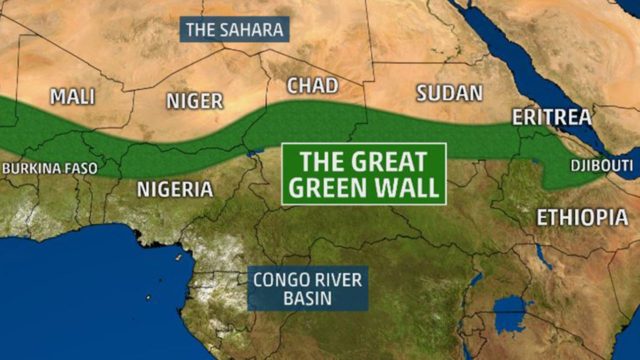
The World’s most ambitious reforestation project, the Great Green Wall of Africa, has just covered only 4% of its targeted area but it’s however more than halfway towards its 2030 completion date according to a Status report.
More funds will definitely be required as well as greater technical support and tighter oversight if the plan to plant 100m hectares of trees and other vegetation is to be realised, says the author of the study, which was unveiled in a meeting of the regional ministers.
The Great Green Wall was conceived in 2007 by the African Union as a 7,000km (4,350-miles) cross- continental barrier stretching from Senegal to Djibouti that would hold back the deserts of Sahara and Sahel.
Its supporters say it will improve livelihood in one of the world’s poorest regions, capture carbon dioxide and reduce conflict, terrorism and migration.
During the launch of the report, Ministers and the United Nations officials highlighted the achievements so far:
more than 350,000 new jobs from $90m (70m) in revenues and 18m hectares of land restoration in participating countries.
The UN Deputy Secretary General Amina Mohammed in a statement affirmed that, ” The Great Green Wall, is a new world wonder in the making. It shows that if we work with nature, rather than against it, we can build a more sustainable and equitable future.”
It’s noteworthy to state that, in terms of the targeted area, progress has been far less impressive. After an investment of more than $200m, only 4m hectares have been planted in the past decade.
In order to achieve the 2030 target, more than twice that area will need to be planted and a restored twice every year at an annual cost of $4.3bn.
The African Union’s Commissioner for Rural Economy and Agriculture Josefa Sacko said that, ” The time for business as usual is over and he called for a more sustainable agriculture, clean energy and water management to deal with the dry lands of Africa.
The results varied enormously from country to country. Ethiopia for instance which began reforestation earlier than other nations in the region is at the fore front having reportedly planted 5.5bn seedlings on 151,000 hectares of new forest and 792,000 of new terraces.
Other countries on the other hand, have lagged behind due to different geographical conditions, level of government policies and economic development. Burkina Faso planted 16.6m plants and seedlings while Chad planted 1.1m, though both nations received more financial support for the project.
One of the major challenges in all of these is monitoring. Observation and experience has shown that individual nations, provides their own estimates, and there are doubts as to how many of the 12m trees planted in Senegal for example, have survived.
Salwa Bahbah, a research analyst with Climatekos, the firm hired to draw up report said that, ”One of the main problems we had was to try to track the project because there is not a good monitoring and evaluation system in place. We don’t know where the money goes exactly and how it is used.”
Some scientists have expressed scepticism about creating walls of trees when grass lands can be more effective in certain regions. Shifting climates patterns have also slowed or reversed the expansion of some deserts. There is also greater political support for investing in soil restoration and water management of productive areas rather than planting trees in remote, sparsely inhabited areas. This has affected the objectives, if not the enthusiasm and effectiveness of the project.
Chris Reij of the World Resources Institute said the modest results until now showed the need for more focus on what has and has not worked..”
He continued, ”am a fan of the Great Green Wall it is a very useful initiative which shows the strong will of political governments to fight land degradation but am also critical of the initial idea of planting a green wall in areas less than 400mm of rainfall… ” it is now about creating great green and productive landscapes… there’s a ton of good experiences across the Sahel upon which it’s possible to build he concluded.







